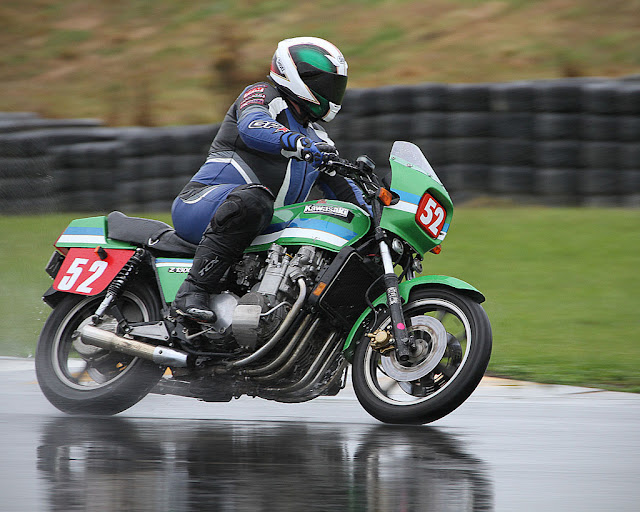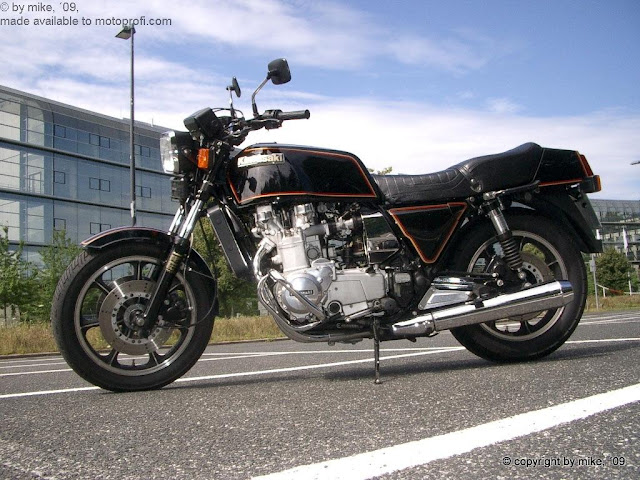Kawasaki Z1300
Kawasaki made no attempt to disguise the size of the Z1300, whose oversized fuel tank and bodywork dwarf even the huge engine. There was also little visual attempt to highlight the six cylinder layout. The exhaust downpipes were partially obscured by the radiator, and there were only two silencers.
The gigantic six-cylinder Zl 300 arrived in 1979 to mark the end of a decade that had seen great change in superbikes’ performance, size and technical specification. This I20bhp behemoth was not simply the world’s most powerful production motorcycle, it was fully I5bhp more potent than its closest challenger, Honda’s CBX1000, and also produced more power than many cars.
Ironically the Kawasaki was not the brutal performance machine that its vital statistics and enormous slab-sided bodywork suggested. The Z1300 was notable for its sophistication and smoothness, as much as for its horsepower. With its upright riding position, liquid cooling and shaft final drive, the big Six was less of an aggressive sports machine than a grand tourer, albeit one without the convenience of a fairing.
Fast and torquey
The Z1300 was mighty fast for all that, with a top speed of almost 140mph (225km/h) despite the aerodynamics of a small building. Although it weighed over 670lb (304kg) with fuel, it was awesomely quick off the line, matching even the best rival four-cylinder rivals. And the Kawasaki had superbly strong mid-range power delivery too, giving instant throttle response that made the big bike effortless to ride.
That performance came from a 1286cc motor that was conventional in its dohc, two-valves-per- cylinder top-end layout, if in nothing else. Liquid cooling allowed the cylinders to be spaced more closely together than with an air-cooled design. Long-stroke dimensions of 62 x 71mm also helped keep the motor reasonably narrow, despite its alternator’s location on the end of the crankshaft. Like the engine, the chassis owed much to Kawasaki's previous fours. The twin-cradle frame’s steel tubes were thicker than normal, and held strong 4lmm leading-axle forks. Simple twin shocks took care of suspension at the rear. Wheels and tyres were broad, in an attempt to control all that power and weight.
Considering the Kawasaki’s size, it handled surprisingly well. The combination of strong frame and competent suspension made the Z1300 much less of a handful than it might have been, giving a reassuringly stable feel even at high speed. The big bike even felt respectably agile in tighter bends, and its triple-disc brake system worked well.
Even so, the Z1300 failed to sell in large numbers. That was partly because it was much more expensive than rival fours, but ultimately no faster, more practical or more exciting to ride. The bike was capable of cruising at lOOmph (I6lkm/h) indefinitely, but its high handlebars and forward-set footpegs meant its rider was not, at least not for long. Throttle response was slightly snatchy and, although the Six was smooth, it had a busy feel that did not make for relaxed cruising.
The Zl300’s arrival highlighted Japanese manufacturers’ fixation with ever greater power, weight and complexity, but Kawasaki’s timing was not good. In the midst of an oil crisis, the West German government had recently introduced a lOObhp power limit. Thoughts were turning towards economy and efficiency. Words such as ‘overkill’ were commonly used in road tests, some of which claimed the Z1300 would lead to bikes being banned.
That did not happen, but the Z1300 proved a turning point because, from then on, manufacturers aimed to improve performance through increased engine, aerodynamic and chassis efficiency, rather than simply raw power and size. The mights Z1300 gained a certain cult status though, and remained in production, with very few changes, right up until 1989 - serving as a rolling reminder of 1970s' superbike excess.
Handling was good, given the limitations of the Kawasaki’s size. Suspension was reasonably firm, the tubular steel frame was rigid, and the bike even had a respectable amount of ground clearance. At slower speeds, the Z 1300's long wheelbase helped make for relatively easy manoeuvring, despite the bike’s weight and tall seat.
The headlamp’s angular shape was echoed in other features including indicators and instrument console. With so much power on tap, aerodynamics were not a consideration.
At close to 3001b (136kg) even without its drive shaft, the Z1300’s liquid-cooled engine alone weighed more than some complete bikes. The 1286cc six-cylinder 120bhp motor was motorcycling’s most powerful by 15bhp.
Specification Kawasaki Z1300 (1979)
- Engine Liquid-cooled dohc 12-valve six
- Capacity 1286cc (62 x 71mm)
- Maximum power 120bhp @ 8000rpm
- Transmission Five-speed, shaft final drive
- Frame Steel twin cradle
- Suspension Telescopic front; twin shocks rear
- Brakes Twin discs front; disc rear
- Weight 672lb (305kg) wet
- Top speed 135mph (217km/h)






















0 comments: